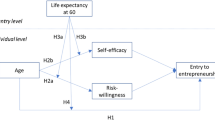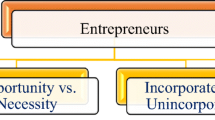Abstract
This article investigates the impact of perceived age norms on the formation of entrepreneurial intentions in the third age. Age norms refer to those social norms that determine whether establishing and running a business are considered appropriate behavior for a mature individual. An empirical analysis of Finnish individuals finds that norms perceived as permissive of enterprising activity in the third age exert a significant positive influence on entrepreneurial intentions in this segment, even when controlling for the general level of entrepreneurship in the municipalities. This influence is partially mediated by whether the individual has a positive attitude toward entrepreneurship, by how the individual perceives their own ability to start and run a business, by the extent of support from their family and friends they perceive and by the importance of that support to them. Thus, if policy aims to increase enterprising activity in the third-age segment, the portfolio of instruments should include measures that address people’s general awareness of third-age entrepreneurship as a viable, positive and attractive late-career option.

Similar content being viewed by others
References
Acs, Z. J., Desai, S., & Hessels, J. (2008). Entrepreneurship, economic development and institutions. Small Business Economics, 31(3), 219–234.
Ajzen, I. (1988). Attitudes, personality, and behavior. Chicago: Dorsey Press.
Ajzen, I. (1991). The theory of planned behavior. Organizational Behavior and Human Decision Processes, 50(2), 179–211.
Ajzen, I. (2002). Residual effects of past on later behavior: Habituation and reasoned action perspective. Personality and Social Psychology Review, 6(2), 107–122.
Ajzen, I., & Fishbein, M. (2004). Questions raised by reasoned action approach: Comment on Odgen (2003). Health Psychology, 23(4), 431–434.
Audretsch, D. B., & Fritsch, M. (1994). On the measurement of entry rates. Empirica, 21(1), 105–113.
Audretsch, D. B., & Fritsch, M. (2002). Growth regimes over time and space. Regional Studies, 36(2), 113–124.
Bandura, A. (1977). Self-efficacy: Toward a unifying theory of behavioral change. Psychological Review, 84(2), 191–215.
Baron, R. M., & Kenny, D. A. (1986). The moderator–mediator variable distinction in social psychological research: Conceptual, strategic, and statistical considerations. Journal of Personality and Social Psychology, 51(6), 1173–1182.
Baucus, D. A., & Human, S. E. (1994). Second-career entrepreneurs: A multiple case study analysis of entrepreneurial processes and antecedent variables. Entrepreneurship Theory and Practice, 19(2), 41–71.
Bird, B. (1988). Implementing entrepreneurial ideas: The case for intention. Academy of Management Review, 13(3), 442–453.
Botham, R., & Graves, A. (2009). Third age entrepreneurs: Innovative business start ups in mid-life and beyond—understanding the drivers and removing the barriers. Interim report to NESTA, February 2009.
Carr, J. C., & Sequeira, J. M. (2007). Prior family business exposure as intergenerational influence and entrepreneurial intent: A theory of planned behavior approach. Journal of Business Research, 60(10), 1090–1098.
Chin, W. W. (1998). The partial least squares approach to structural equation modelling. In G. A. Marcoulides (Ed.), Modern methods in business research (pp. 295–336). Hillsdale, NJ: Erlbaum.
Chin, W. W. (2000). Frequently asked questions—partial least squares & PLS-Graph. http://disc-nt.cba.uh.edu/chin/plsfaq.htm.
Chiu, W. C. K., Chan, A. W., Snape, E., & Redman, T. (2001). Age stereotypes and discriminatory attitudes towards older worker: An east–west comparison. Human Relations, 54(5), 629–661.
Churchill, G. A., Jr. (1979). A paradigm for developing better measures of marketing constructs. Journal of Marketing Research, 16(1), 64–73.
Cohen, J. (1988). Statistical power analysis for the behavioral sciences. Hillsdale, NJ: Erlbaum.
Cote, J. A., & Buckley, M. R. (1987). Estimating trait, method and error variance: Generalizing across 70 construct validation studies. Journal of Marketing Research, 24(3), 315–318.
Curran, J., & Blackburn, R. (2001). Older people and the enterprise society: Age and self-employment propensities. Work Employment and Society, 15(4), 889–902.
Fink, M., Harms, R., & Kraus, S. (2008). Cooperative internationalization of SMEs: Self-commitment as a success factor for international entrepreneurship. European Management Journal, 26(6), 429–440.
Fishbein, M., & Ajzen, I. (1975). Belief, attitude, intention and behavior: An introduction to theory and research. Reading, MA: Addison-Wesley.
Fornell, C., & Bookstein, F. L. (1982). Two structural equation models: LISREL and PLS applied to consumer exit-voice theory. Journal of Marketing Research, 19(4), 440–452.
Fornell, C., & Larcker, D. F. (1981). Evaluating structural equation models with unobservable variables and measurement error. Journal of Marketing Research, 18(1), 39–50.
Fritsch, M. (2004). Entrepreneurship, entry and performance of new business compared in two growth regimes: East and West Germany. Journal of Evolutionary Economics, 14(5), 525–542.
Fritsch, M., & Mueller, P. (2007). The persistence of regional new business formation-activity over time—assessing the potential of policy promotion programs. Journal of Evolutionary Economics, 17(3), 299–315.
Giannetti, M., & Simonov, A. (2004). On the determinants of entrepreneurial activity: Social norms, economic environment and individual characteristics. Swedish Economic Policy Review, 11(2), 269–313.
Giddens, A. (1984). The constitution of society: Outline of the theory of structuration. Cambridge: Polity Press.
Harman, H. H. (1976). Modern factor analysis (3rd ed.). Chicago: University of Chicago Press.
Hart, M., Anyadike-Danes, M., & Blackburn, R. (2004, November). Entrepreneurship and age in the UK: Comparing third age and prime age new venture creation across the regions. Paper presented at RENT XVIII, Copenhagen.
Hox, J. (2002). Multilevel analysis: Techniques and applications. Mahwah, NJ: Erlbaum.
Jacoby, J. (1978). Consumer research: How valid and useful are all our consumer behavior research findings? A state of the art review. Journal of Marketing, 42(2), 87–96.
Johnson, P., & Zimmermann, K. F. (1993). Ageing and the European labour market: Public policy issues. In P. Johnson & K. F. Zimmermann (Eds.), Labour markets in an ageing Europe (pp. 1–25). Cambridge: Cambridge University Press.
Kangasharju, A. (2000). Regional variations in firm formation: Panel and cross-section data evidence from Finland. Papers in Regional Science, 79(4), 355–373.
Kautonen, T. (2008). Understanding the older entrepreneur: Comparing third age and prime age entrepreneurs in Finland. International Journal of Business Science and Applied Management, 3(3), 3–13.
Kautonen, T., Down, S., & South, L. (2008). Enterprise support for older entrepreneurs: The case of PRIME in the UK. International Journal of Entrepreneurial Behaviour & Research, 14(2), 85–101.
Koch, L. T. (1998). Kognitive Determinanten der Problementstehung und -behandlung im wirtschaftspolitischen Prozeß. Zeitschrift für Wirtschafts- und Sozialwissenschaften, 118, 597–622.
Kolvereid, L. (1996). Prediction of employment status choice intentions. Entrepreneurship Theory and Practice, 21(1), 47–57.
Krueger, N. F., & Carsrud, A. L. (1993). Entrepreneurial intentions: Applying the theory of planned behavior. Entrepreneurship and Regional Development, 5(4), 315–330.
LaFuente, E., Vaillant, Y., & Rialp, J. (2007). Regional differences in the influence of role models: Comparing the entrepreneurial process of rural Catalonia. Regional Studies, 41(6), 779–795.
Lawrence, B. S. (1988). New wrinkles in the theory of age: Demography, norms, and performance ratings. Academy of Management Journal, 31(2), 309–337.
Lévesque, M., & Minniti, M. (2006). The effect of aging on entrepreneurial behavior. Journal of Business Venturing, 21(2), 177–194.
Liñán, F., & Chen, Y.-W. (2009). Development and cross-cultural application of a specific instrument to measure entrepreneurial intentions. Entrepreneurship Theory and Practice, 33(3), 593–617.
Lohmöller, J.-B. (1989). Latent variable path modelling with partial least squares. Heidelberg: Physica.
Lundström, A., & Stevenson, L. A. (2005). Entrepreneurship policy: Theory and practice. New York: Springer.
McKay, R. (2001). Women entrepreneurs: Moving beyond family and flexibility. International Journal of Entrepreneurial Behavior & Research, 7(4), 148–165.
Mitchell, R. K., Mitchell, J. R., & Smith, J. B. (2008). Inside opportunity formation: Enterprise failure, cognition, and the creation of opportunities. Strategic Entrepreneurship Journal, 2(3), 225–242.
Neugarten, B. L., Moore, J. W., & Lowe, J. C. (1965). Age norms, age constraints, and adult socialization. American Journal of Sociology, 70(6), 710–717.
OECD. (2001). Fiscal implications of ageing: Projections of age-related spending. OECD Economic Outlook, 69(IV), 145–167.
Pe’er, A., & Vertinsky, I. (2008). Firm exits as a determinant of new entry: Is there evidence of local creative destruction? Journal of Business Venturing, 23(3), 280–306.
Platman, K. (2004). “Portfolio careers” and the search for flexibility in later life. Work, Employment and Society, 18(3), 573–599.
Podsakoff, P. M., MacKenzie, S. B., Lee, J.-Y., & Podsakoff, N. P. (2003). Common method biases in behavioral research: A critical review of the literature and recommended remedies. Journal of Applied Psychology, 88(5), 879–903.
PRIME. (2005). Reaching the older workless—an evaluation of PRIME’s enterprise South Tyneside outreach project. Final Report, July.
Reynolds, P. D., Hay, M., Bygrave, W. D., Camp, S. M., & Autio, E. (2000). Global Entrepreneurship Monitor: 2000 Executive report. Missouri: Kauffman Center for Entrepreneurial Leadership.
Ringle, C. M., Wende, S., & Will, A. (2005). SmartPLS 2.0.M3. http://www.smartpls.de.
Ritsilä, J. J. (1999). Regional differences in environments for enterprises. Entrepreneurship and Regional Development, 11(2), 187–202.
Rotefoss, B., & Kolvereid, L. (2005). Aspiring, nascent and fledgling entrepreneurs: An investigation of the business start-up process. Entrepreneurship and Regional Development, 17(2), 109–127.
Settersten, R. A., & Mayer, K. U. (1997). The measurement of age, age structuring, and the life course. Annual Review of Sociology, 23, 233–261.
Shane, S. (2000). Prior knowledge and the discovery of entrepreneurial opportunities. Organization Science, 11(4), 448–469.
Singh, G., & DeNoble, A. (2003). Early retirees as the next generation of entrepreneurs. Entrepreneurship Theory and Practice, 23(3), 207–226.
Smallbone, D., & Welter, F. (2001). The distinctiveness of entrepreneurship in transition economies. Small Business Economics, 16(4), 249–262.
Srite, M., & Karahanna, E. (2006). The role of espoused national cultural values in technology acceptance. MIS Quarterly, 30(3), 679–704.
Statistics Finland. (2009). Statistical grouping of municipalities 2009. http://www.stat.fi/meta/luokitukset/kuntaryhmitys/001-2009/index_en.html.
Tkachev, A., & Kolvereid, L. (1999). Self-employment intentions among Russian students. Entrepreneurship and Regional Development, 11(3), 269–280.
Vaillant, Y., & LaFuente, E. (2007). Do different institutional frameworks condition the influence of local fear of failure and entrepreneurial examples over entrepreneurial activity? Entrepreneurship and Regional Development, 19(4), 313–337.
von Nordheim, F. (2004). Responding well to the challenge of an ageing and shrinking workforce: European Union policies in support of member state efforts to retain, reinforce & re-integrate older workers in employment. Social Policy & Society, 3(2), 145–153.
Walker, E. A., & Webster, B. J. (2007). Gender, age and self-employment: Some things change, some stay the same. Women in Management Review, 22(2), 122–135.
Weber, P., & Schaper, M. (2004). Understanding the grey entrepreneur. Journal of Enterprising Culture, 12(2), 147–164.
Webster, B. J., Walker, E. A., & Turner, J. (2005, June). Smart training for the older entrepreneur. Paper presented at the ICSB 2005 world conference, Melbourne.
Wold, H. (1985). Partial least squares. In S. Kotz & N. L. Johnson (Eds.), Encyclopedia of statistical sciences (Vol. 6, pp. 581–591). New York: Wiley.
Yung, Y.-F., & Bentler, P. M. (1996). Bootstrapping techniques in analysis of mean and covariance structures. In G. A. Marcoulides & R. E. Schumacker (Eds.), Advanced structural equation modelling: Issues and techniques (pp. 195–226). Mahwah, NJ: Erlbaum.
Author information
Authors and Affiliations
Corresponding author
Appendix
Rights and permissions
About this article
Cite this article
Kautonen, T., Tornikoski, E.T. & Kibler, E. Entrepreneurial intentions in the third age: the impact of perceived age norms. Small Bus Econ 37, 219–234 (2011). https://doi.org/10.1007/s11187-009-9238-y
Accepted:
Published:
Issue Date:
DOI: https://doi.org/10.1007/s11187-009-9238-y




